
NO. 7 SUMMER 2023
Communities
Member of Edible
Sweet Finds edible maritimes the land ~ the sea ~ the people ~ the food












Baked Poached Grilled This Summer, enjoy your eggs anytime, any way! eggspei.ca Visit the Egg Farmers in your province for recipes and more!

RESTAURAN T. OYSTER BAR. BREW ERY.
Great food, fresh oysters, and beer brewed in our on-site breweries. With our top-tier East Coast hospitality and delicious food & drinks, we hope you feel right at home.
Love
Please enjoy responsibly.
at first sip.
GAHAN.CA


www.algonquinresort.com
St. Andrews, N.B.
Wind down after a round.
From our Smokehouse BBQ & Bar restaurant to our pools and full-service day spa, The Algonquin Resort invites you to experience St. Andrews by-the-sea in style.




Custom Design Quality Craftsmanship cabinetsbyqueenstown.ca
506-488-3161

TABLE OF CONTENTS 4 HELLO FROM US 5 NIPONI / NIPG 6 FRUIT ON THE FIRE 8 FURLED FRONDS Cecelia Brooks on bracken fernbrakes 10 GOSARI NAMUL A recipe from Cecelia Brooks 12 TAKING A CHANCE ON DOWNTOWN Jolène Thibault and Nigel Eddy and their Campbellton market shop 17 ELDERBERRY KOMBUCHA COCKTAIL A recipe from Marché Dumais 18 THE MIGHTY CHERRY TOMATO Seed saving and tomato roasting 22 THE SMALLEST OF SWEETNESSES Simon Thibault on pie and moments 28 A BREAKFAST CROSSING We take a ferry trip for the breakfast, the views and conversation 34 GREAT FOOD IN THE GREAT OUTDOORS Cooking for the outdoors with Sireena Trafford and Graham Blower 36 SUGAR HI! The creators behind Halo Donuts and Lost and Found Ice Cream 40 DELICIOUS IN COLOUR Emily Lawrence offers up market finds and a buttery recipe 43 THE MADNESS OF AMIEL LEBLANC The LeBlanc family spices things up on P.E.I. 48 ISLAND SYMBIOSIS, SUSTAINABLY Three island foragers on summer foraging On the cover: A sweet stop on a sunny day by Haqq Brice This page: Summer food by Dave Snow

hello from us
Summertime is full of lovely finds, made all the more wonderful when we share them. We offer up this issue just as full of sweet discoveries.
Dig in as Simon Thibault takes us to the kitchen to bake a pie with sweet memories and illustrations by Adam Myatt, while Emily Lawrence turns market finds into buttery goodness. Jennifer Campbell and Jody Nelson bring us local makers of deliciously unique offerings, while Cecelia Brooks and Jennifer Blair take us foraging in the forest and along the shores. Haqq Brice captures tasty treats in the city. And we share a story of downtown revival and another from our favourite way to travel across the Bay of Fundy. Along the way, you'll find recipes we hope you'll enjoy making as much as we do.
Yours in exploring all the sweetness of the Maritimes, Sara & Dave
Sara & Dave Snow
Jennifer Blair
Haqq Brice
Cecelia Brooks
Jennifer Campbell
Emily Lawrence
Adam Myatt
Jody Nelson
Thibault
Photo above: Fresh Strawberries by Dave Snow
Photo next page: Buttercups by Dave Snow


4 edible MARITIMES
& DESIGNERS
CO-EDITORS
(& storytellers)
CONTRIBUTORS
all of you—our readers, advertisers, contributors, our friends and family—for supporting local storytelling and independent print media. We couldn't do it without you!
edible Maritimes is published four times a year. Subscriptions are $32 and available at ediblemaritimes.ca FIND US ONLINE ediblemaritimes.ca instagram.com/ediblemaritimes ADVERTISE WITH US hello@ediblemaritimes.ca ediblemaritimes.ca 506-639-3117 PUBLISHERS Sara & Dave Snow Steadii Creative Inc No part of this publication may be used without written permission by the publisher. Every effort is made to avoid errors, misspellings and omissions. If, however, an error comes to your attention, please accept our sincere apologies and notify us. Thank you, © 2022 Steadii Creative Inc. All rights reserved. We proudly print edible Maritimes in Canada on paper made of material from well-managed, FSC®-certified forests, from recycled material and other controlled sources. Through 1% for the planet we contribute one percent of our revenue to environmental non-profits. edible Maritimes Read it, love it, share it! Please reuse and redistribute this
-
it
and
or pass it on!
Simon
THANK YOU To
SUBSCRIBE
magazine
read
again
again

Language resources:
*Passamaquoddy-Maliseet Language Portal (http://www.pmportal.org); Language Keepers and Passamaquoddy-Maliseet Dictionary Project.
**www.mikmaqonline.org
We respectfully acknowledge that we are in Wabanaki territory, on the unsurrendered and unceded traditional lands of the Wolastoqey/Wəlastəkwey, Mi’kmaq and Passamaquoddy peoples, who have stewarded this land throughout the generations. This territory is covered by the Treaties of Peace and Friendship which the Wolastoqey/Wəlastəkwey, Mi’kmaq and Passamaquoddy peoples first signed with the British Crown in 1725 recognizing Wolastoqey/Wəlastəkwey, Mi’kmaq and Passamaquoddy title. We stand with them in their efforts for land and water protection and restoration, and for cultural healing and recovery.
Edible Maritimes
summer*,
nipg
niponi of
Passamaquoddy and Wolastoqey
summer**, Mi'kmaq

FRUIT ON THE FIRE
An easy dessert for those large gatherings around the campfire
What you'll need:
3 or 6 liter three-legged cast iron (potjie) pot
4 cups chopped rhubarb
4 cups cleaned and sliced strawberries
1 1/2 cups sugar
1/2 cup maple syrup
3 tablespoons flour or corn syrup
1/4 cup butter
1/4 cup local whiskey or bourbon
Pre-prepared biscuits, scones or oatmeal crumble
Set your small fire (with kindling) early so you have nice hot coals to cook over. Add first five ingredients to the pot and cover. Place pot over hot coals. Bring to a simmer and stir often until fruit is soft, about 30 minutes. Add butter and whiskey. Continue to simmer until liquid begins to thicken slightly.
Remove from heat and serve in bowls topped with pre-made biscuits, scones, ice cream or oatmeal crumble.
Happy Summer, Sara & Dave

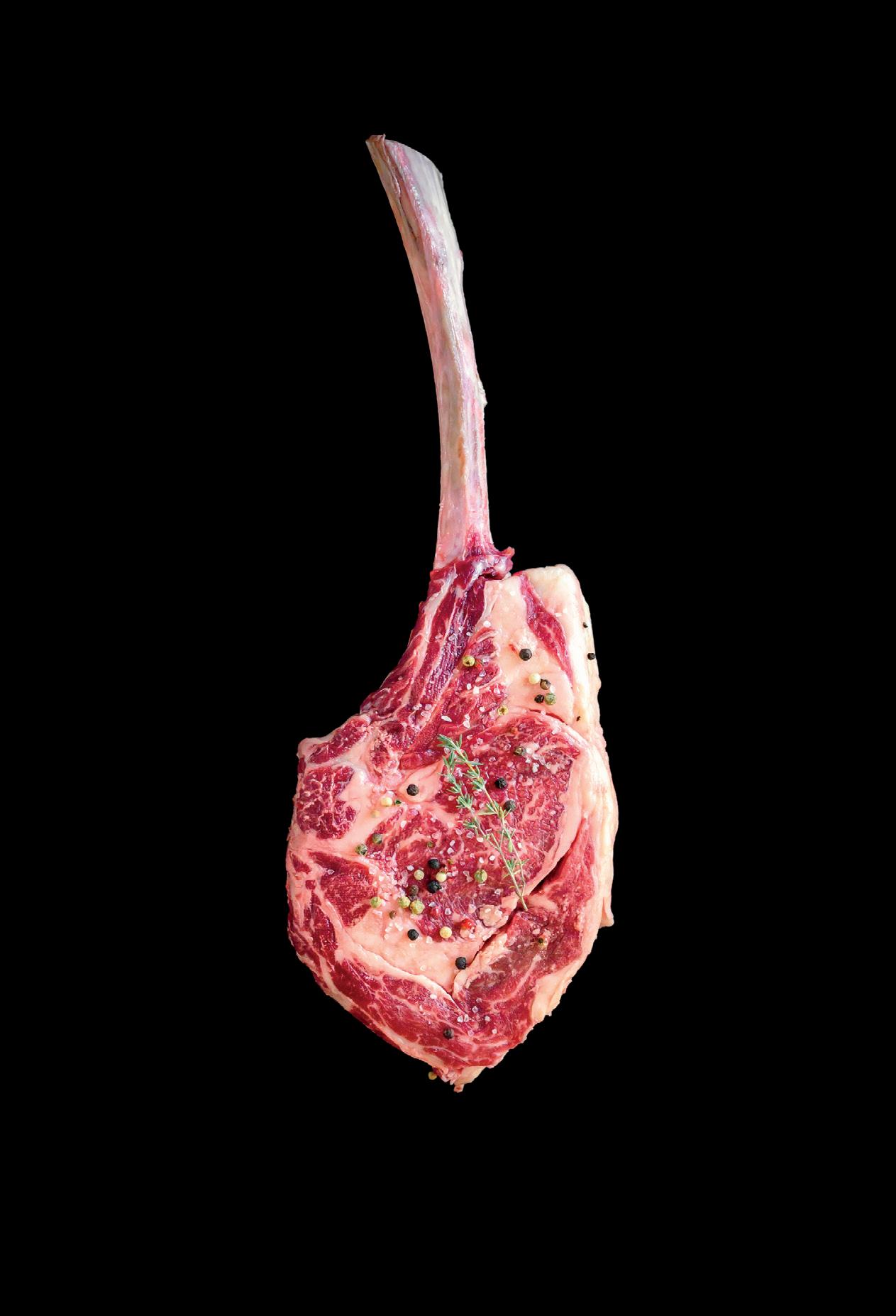

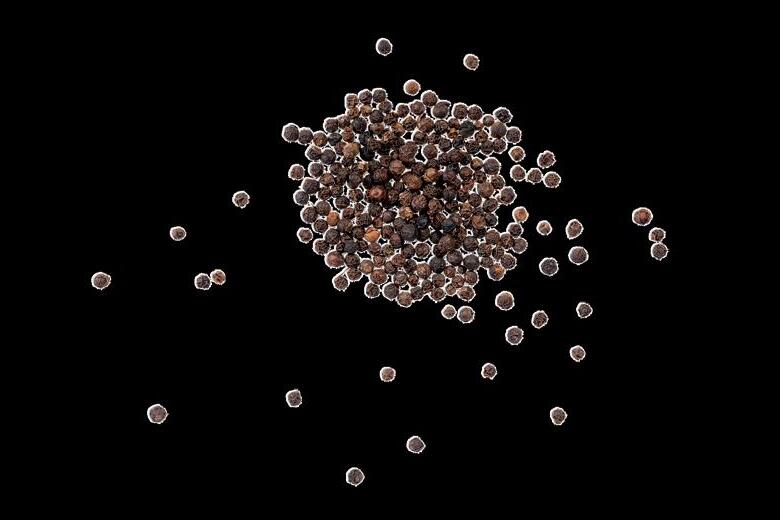




Furled finds
Cecelia Brooks on the often abundant but frequently overlooked fernbrake
WORDS BY CECILIA BROOKS PHOTO BY DAVE SNOW

When the waters of the spring freshet finishes its journey down our many waterways to expose the river islands to sunlight, the first abundant sprouts of the delicious ostrich fern ( Matteuccia struthiopteris ) are ready to harvest. Our Wabanaki ancestors gathered and ate these treats as a spring tonic to end the long winter of eating preserved nuts, meats, fruits and vegetables from the previous year.
The first canoe trips down the streams were taken with the purpose of gathering the fronds of the ostrich fern, known by many now as fiddleheads. You can gather your own along the banks if you do not have a canoe or buy them from the many pickers who sell them along the side of the road—or at the farmers’ markets. Eating fiddleheads has become somewhat of a springtime ritual for many Maritimers ever since our Wabanaki ancestors first introduced the settler population to them. Some like to sauté them in a generous amount of butter as a side dish to a main course, but I like them best boiled together with salmon and potatoes. The juice they are boiled in is used like a gravy, as it is served over the entire meal to add flavor to the bowl of goodness. This is the way many Wabanaki people eat them each spring to celebrate surviving another winter.
Whichever way you like to eat them—whether it’s pickled, sautéed in butter, grilled on an open fire or baked into a quiche, the most important thing is to make sure they are cleaned well and cooked thoroughly. I have heard too many stories of people new to the region or those unaware of the risk of not cooking them sufficiently to prevent suffering the consequences of gastrointestinal upset. To ensure the fiddleheads are cooked well it is a good idea to parboil them prior to using them in a recipe if you plan to eat them any other way than boiling them.
A lesser-known spring ephemeral that our family forages each spring are the fronds of the bracken fern ( Pteridium aquilinum ). These can be found in abundance in the uplands, just when the ostrich fern fiddleheads are no longer edible, as they are unfurling into mature ferns. The bracken fern is deemed to be the most abundant species in the maritime uplands, yet they are not well known and for the most part are not gathered as food. Some of this unpopularity is possibly due to the conflicting information found through online sources that claim it harbors a carcinogen (Ptaquiloside), making them dangerous for human consumption. Ptaquiloside is not itself a carcinogen, but can be converted in an alkaline
environment to dienone, which is a true carcinogen. Most ptaquiloside poisoning comes from consuming milk from cows who have eaten an abundance of the ferns where the toxin is converted to the carcinogen dienone in the cow’s stomach.
The good news that my Korean ancestors obviously figured out is that ptaquiloside is water soluble and neutralized by heat. Hence, the process my mother put these fernbrakes through (blanching, drying and soaking) removes and neutralizes the toxin.
I have gathered bracken fernbrakes with my mother since I was a child and helped her process them each spring by first blanching them, then drying them for later use.
She stored them dried in paper bags and rehydrated them overnight; then boiled them in a few changes of water before sautéing them in sesame seed oil with garlic and soy sauce. Our family continues this tradition each spring to keep the knowledge alive and to have bracken fern on hand to add to various Korean dishes throughout the year.
Bracken fernbrakes keep very well as a dried vegetable if stored in a paper bag to keep them dry. Their meaty texture is a delicious addition to stir-fry dishes eaten with rice. Bracken fernbrakes are a traditional topping on Korean Bi-Bim-Bap, but rarely seen in the restaurant versions. But if you are fortunate enough to have that dish made by a Korean in their home, you will likely get a taste of that treat. Some Asian food stores have the dried fernbrakes for sale, but I prefer to pick my own as we have some of the best bracken fernbrakes in Canada, according to my Korean relatives. You'll find my recipe for Gosari Namul (Bracken Fernbrake vegetable sidedish) on the next page.
Whichever fernbrake you decide to harvest (maybe both) make sure you have a positive identification before picking. There are several look-a-likes for each type, so a good field guide is a must when it comes to venturing out to collect foods in the wild.
Cecelia Brooks is the Wabanaki Foodways Instructor at Hayes Farm in Fredericton, N.B..
www.hayesfarm.ca
SUMMER 2023 9
Gosari Namul
Cecelia Brooks shares her recipe for Korean fernbrake vegetable sidedish

6 oz hydrated bracken fernbrake, boiled with two changes of water and soaked in cold water, drain
1 teaspoon toasted sesame seeds
Vegetable oil for cooking
Seasoning blend for fernbrake:
1 tablespoon soy sauce
1 tablespoon roasted sesame oil
1 thinly sliced green onion
1 garlic clove, minced
¼ teaspoon sea salt
Cut the fernbrakes into bite size pieces and mix thoroughly with the seasoning blend. Heat the oil in a skillet over medium high heat and add the seasoned fernbrake and stir-fry for 3 minutes. Add 3 tablespoons of water and reduce temperature to low and simmer for an additional 3 minutes. Add the sesame seeds and remove from heat onto a serving dish. Enjoy with rice. Store leftovers up to 4 days in an airtight container in the refrigerator.

S tead Creat ve


Inspired strategies for enduring
brands
steadiicreative.ca



Taking a chance on downtown
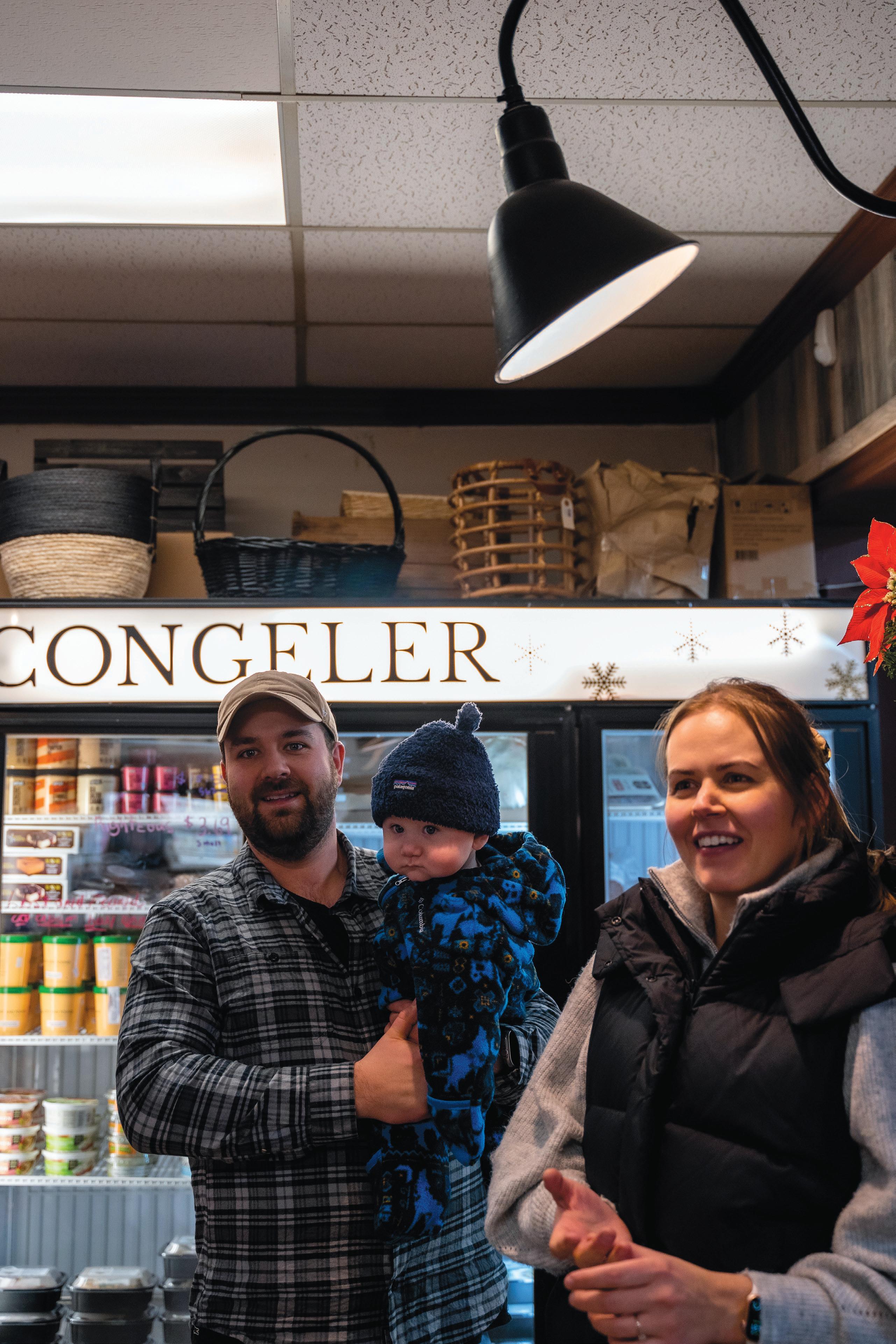
 WORDS BY SARA SNOW PHOTOS BY DAVE SNOW
Nigel Eddy and Jolène Thibault put all their eggs in Marché Dumais Market
WORDS BY SARA SNOW PHOTOS BY DAVE SNOW
Nigel Eddy and Jolène Thibault put all their eggs in Marché Dumais Market

Marché Dumais or Dumais Market is located at the corner of O’Leary and Roseberry Streets in downtown Campbellton, N.B.. It is a low, unassuming building with a brick face and a large sidewalk space out front, perfect for chatting with an old friend about sweet market finds. The sidewalk is bustling this morning with folks picking up provisions at Dumais’ or one of the many shops, restaurants and breweries along Roseberry Street. Campbellton sits at the base of Sugarloaf Mountain, on the south side of the Restigouche River—where it opens up to the Baie de Chaleur. Roseberry street extends nearly the length of the city, parallel to the railway tracks, to Water Street and the river, eventually turning into Restigouche Drive as it makes its way toward Tide Head and Matapédia. Walk along Roseberry Street and you’ll find a mix of older brick buildings and newly re-sided ones and, most conspicuously, many new signs.
The return
New signage has popped up all along this street, indicative of a return to downtown that is taking place here. “There is such a difference from just ten years ago,” Dumais market co-owner Jolène Thibault explains. “People weren’t coming back. People ten years older than me are still in Moncton. But now, people my age, my friends they have all come back, and a lot of us are entrepreneur friends, collaborating with each other and sharing clients.”
Thibault and her husband and business partner Nigel Eddy returned to the region with business backgrounds. Eddy had left to study at Saint Francis Xavier University in Antigonish, N.S., and Thibault to study at Université de Moncton in Moncton. They found jobs in Moncton but wanted to return home.
“Since I was in high school I’ve wanted to have my own shop, my own business,” Eddy explains, “but we really stumbled on this opportunity. We were excited when this shop came up for sale and we gave it a little facelift and put our own stamp on it,” Eddy says.
“We were seeing so many new local products in Moncton and we wanted to share them,” Thibault adds. “This was really spontaneous. We bought it and then we were like ‘Oh my!’”
In the shop
Stephanie Attie is behind the counter, ringing in a customer’s basket of local goods. “Stephanie trained us,” Thibault says, “When we bought it, Stephanie helped us get started.” Attie has worked at Marché Dumais for thirty years and has witnessed transformation in both the shop and town. “It’s always been Dumais,” Attie explains. “It was originally the dad that ran it, he had a farm stand and then his son took over.”
Thibault and Eddy bought the shop just before the pandemic. “When we bought it, it was small, just fruits and vegetables and supplements,” Eddy says. “With Walmart and other big stores coming in the region,”



he explains, “the previous owner was able to find some success with things that Walmart wasn’t doing. We’ve built on that and now it’s what it has become.” Along the shelves and in the refrigerators and freezers you’ll find local honey and hot sauce, meat pies and sausage made in nearby Dalhousie, cheese from Caraquet and honey from Charlo, kombucha and ice cream from Moncton, and chaga from Kedgewick. Eddy and Thibault are keen to discover what people are creating in the region, and throughout the province.
From the back, Eddy carries a stack of freshly-prepared take-away foods to stock one of the refrigerators. Today,
the selection ranges from Carrot Rutabaga Soup to Cod with White Butter Sauce, Pea Soup and Rice Vermicelli and Shrimp Poke Bowls. He talks with a customer about today’s meat pies. At the front of the shop, Thibault greets a customer with her warm smile and fills a large bottle with kombucha.
“We do have traditional convenience products but we are elevating it to more of a focus on local and organic,” Eddy says. “As soon as someone produces something and we bring it in and they go. When we bought the store we had never heard of chaga, for example” he explains, “but it sells.” “We have regular customers who come for the chaga,” Thibault adds. Thibault and Eddy are excited for the growing number of new local growers, makers and artisans and the new wave of community building among entrepreneurs.
Changing downtown Campbellton is no stranger to change. On July 11, 1910, the town was all but destroyed when embers from a riverside sawmill sparked a shingle fire that grew quickly engulfing much of the town. 5,000 people lost their homes and the courthouse, schools, churches, hotels and other businesses were destroyed. People lived in tents and rebuilt the town. Through two world wars when many young residents left for war not to return, this region, like many throughout the Maritimes ebbed and flowed.
Downtown remained the heartbeat of Campbellton as the town flourished once again through the middle of the twentieth century. By the late 1980s and 1990s Campbellton, like much of New Brunswick, was bustling. But, a declining population coupled with a shifting retail landscape throughout the Maritimes, away from independent to larger corporate retailers took its toll on many towns and small cities.
In 2016, Campbellton’s population had dropped 8.3% from 2011, the largest population decline of any municipality across Canada. Twenty years earlier, Martin Patriquin wrote in a 2016 article in MacLean's,
14 edible MARITIMES
New Brunswick had been “in enviable financial shape... with successive surplus budgets and a significant dent in the province’s debt.” He contrasted this with 2016, suggesting that New Brunswick’s economy was in free fall, along with more deaths than births.
Digging in
As community planners in the Campbellton-Restigouche region explore ways to attract young people to stay, Thibault and Eddy demonstrate that a great love for the region and a whole lot of entrepreneurial grit is what their downtown needs. The pandemic tested that grit. “During covid we had to adapt pretty quickly,” Eddy says. “It was pretty stressful at the beginning being small but we have a great clientele, and very supportive,” he adds, “That is very reassuring.” Thibault and Eddy balance a lot, always with a friendly greeting. Not long after they opened shop they had their first baby and Thibault added a new project. “I started making candles on mat leave with my first baby,” she says, “and it just picked up and now it’s very busy.” Ritual by Jolène candles can now be found throughout the Maritimes.

“We are always changing and evolving with the needs of our clients,” Thibault says. “A client may come in and ask for something new, we find it and it becomes popular.” “We collaborate with a lot of small businesses ,” Eddy adds, “for example, the pizza is from a local woodfire pizzeria. We bring in 60 and they sell out in an hour.”
A new generation of local advocates
“Just in the last two or three years, more shops are opening here in downtown,” Eddy says with a smile. “Young entrepreneurs are opening up downtown again and giving old businesses a facelift.” In their 2020 economic report, New Brunswick's Department of Finance and Treasury reported that the broader Cambellton-Miramichi region experienced record job gains of +1.7%.
Part of the draw can be attributed to the place. This region, at the top of the Maritimes, is home to some of the most spectacular settings for hiking, mountain biking and cycling, skiing, fly-fishing, and simply just exploring. “When I was little we always hiked Sugarloaf,” Thibault says, “But now there are so many more things to do as well, like mountain bike trails. And with children there is so much more available.”
Running a popular market means Thibault and Eddy meet a

SUMMER 2023 15
lot of new people to the region. “We get to talk a lot with our customers,” Thibault says, “One young couple from Moncton just moved here! It’s one thing for us because we grew up here so we ask why did you move here and they say the mountain and the outdoors. A couple from Ontario just moved back to retire. We see a lot of young people but also people who have come here to retire.”
“It is not as touristy here,” Eddy adds, “but there is a small change going on.”
Patriquin titled his 2016 article “Can anything save New Brunswick?” and ended his piece with a nod to young entrepreneurs. On the sidewalk in front of Marché Dumais in this little city on the great Restigouche, it is clear that the answer is right here and it’s a definitive yes. Thibault and Eddy are part of new generation of young entrepreneurs putting their heart, creativity and tenacity into their home towns and leading a regeneration of local community throughout the Maritimes.
82 Roseberry Street, Campbellton, N.B. @dumaismarket

Page 12: Eddy and Thibault and their youngest son
Page 13: Attie ringing in a customer's order
Page 14 top: stocked shelves at Marche Dumais
Page 14 bottom: Roseberry Street ca 1920s Provincial Archives of NB reference number P46-208
Page 15 top: freezer full of Lost and Found ice cream
Page 15 bottom: Thibault with one of her handmade candles
This page left: Thibault and Eddy in front of their shop.
This page below right: Roseberry Street 1980s Provincial Archives of NB reference number P225-11679
This page bottom right: 82 Roseberry Street in the background of a memorial event 1950s Provincial Archives of NB reference number P978-1-127



16 edible MARITIMES

This bright, bubbly drink will be your new favourite for those warm summer evenings. Makes one serving so multiply for friends and serve in 6-8 ounce glasses
4 ounces elderberry kombucha or your favourite kombucha
Splash of fresh grapefruit juice
2 ounces grapefruit sparkling water
1 ounce gin or vodka (optional)
Add 3-4 ice cubes to your glass and add all ingredients.
Gently stir and enjoy!
Elderberry Kombucha Cocktail
A Marché Dumais Market recipe
The mighty cherry tomato
Cherry tomatoes may be tiny, compared with larger varieties, but they are packed with flavour. This summer, one of the tomatoes we’re adding to our garden is the Acadian Cherry Tomato. This compact variety grows to about three feet tall and can be grown in the garden or in a pot. We’re growing this variety as part of a Seeds of Diversity Community Grow-Out. Community grow-outs are a great opportunity for home gardeners to contribute to heirloom seed libraries and to get those heirloom seeds growing in their own gardens.
Check out Seeds of Diversity at seeds.ca to learn more about seed saving and sharing initiatives.
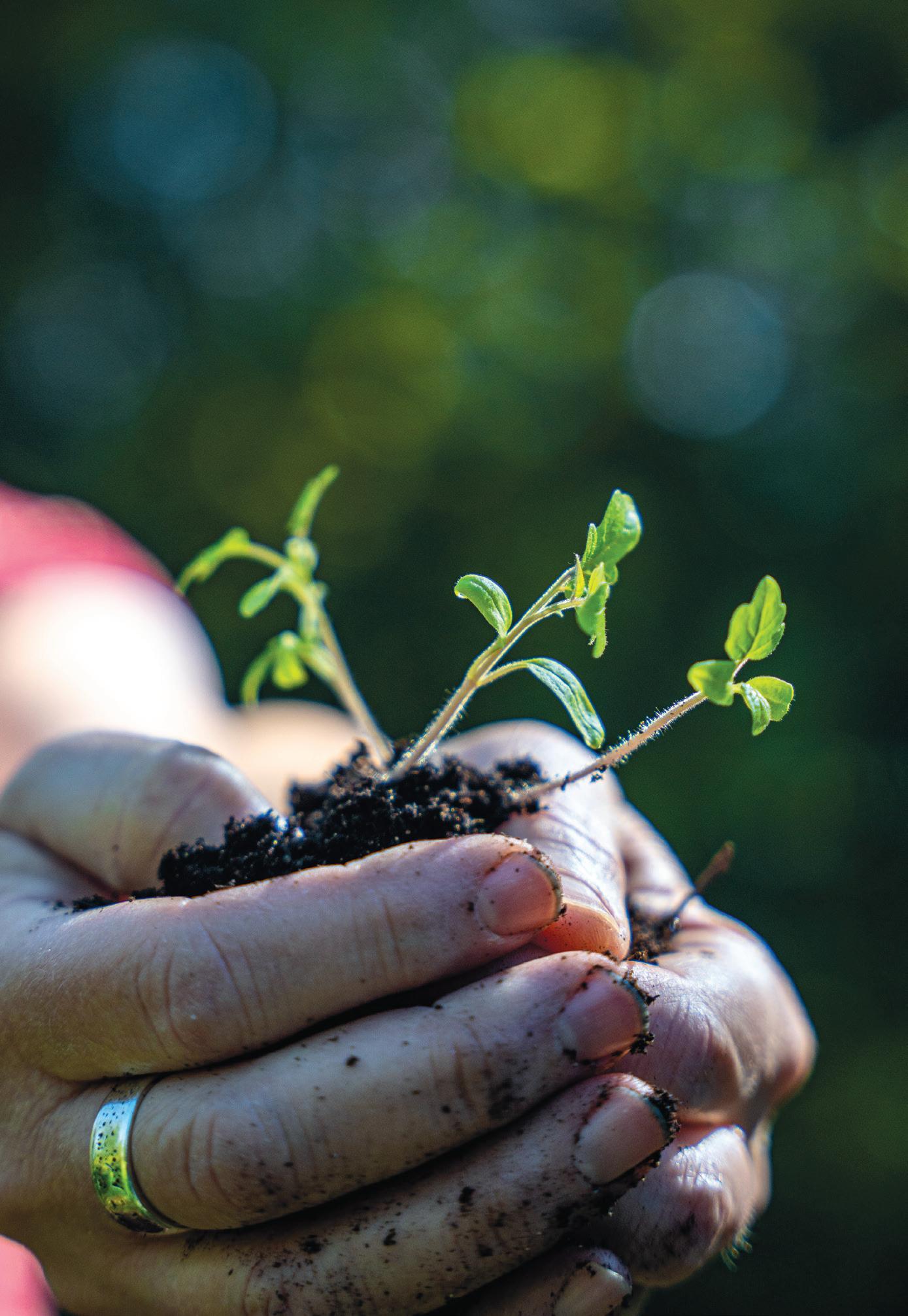
WORDS BY SARA SNOW
PHOTOS BY DAVE SNOW

Roast those little beauties
8 cups sliced cherry tomatoes (add other types of tomatoes if you have them)
8 cloves of garlic, crushed and minced
5-7 garlic scapes chopped finely (optional)
1/4 cup of olive oil
1 teaspoon of sea salt (or to taste)
1 pinch of chili flakes
Fresh basil leaves
Combine all ingredients in a cast iron frying pan and place on a 300˚ barbecue and roast for 2 hours, stirring every 30 minutes. Add roasted tomato mixture directly to cooked pasta and toss or on toasted slices of baguette for a delicious appetizer. For a saucier sauce, blend roasted tomato mixture in a blender or food processor to desired consistency.
Enjoy!

Scan the code below to get your FREE copy of Simply Seasonal: Easy Farmers' Market Recipes for Local Eating.
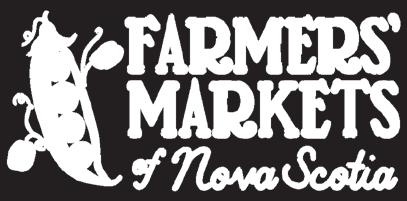


Exploring the Intersection of Acadian, Cajun & French Cuisine &Culture




SUMMER 2023 19 CHOOSE CANADIAN DAIRY FOR COOL SUMMER TREATS For recipes and more, sign-up for our newsletter 100% CANADIAN MILK. HIGH QUALITY. HIGH STANDARDS.
W W W . F A R M E R S M A R K E T S N O V A S C O T I A . C A
CUISINE
FRENCH
E T CULTURE
23-29 OCTOBRE 2023 WOLFVILLE, NOVA SCOTIA / NOUVELLE-ÉCOSSE
Voyagez au cœur des cuisines et des cultures Acadiennes, Cajuns et Françaises OCTOBER






20 edible MARITIMES
LAITIERS CANADIENS POUR VOUS
recettes
LAIT 100 % CANADIEN. HAUTE QUALITÉ. NORMES ÉLEVÉES. www.handp e.ca SUBSCRIBE ediblemaritimes.ca
CHOISISSEZ LES PRODUITS
RAFRAÎCHIR CET ÉTÉ Pour des
et plus encore, inscrivez-vous à notre infolettre.


This summer, discover our natural spaces, innovative places, and our welcoming faces.
Hampton, New Brunswick www.hampton.ca



SUMMER 2023 21

WORDS BY SIMON THIBAULT ILLUSTRATIONS BY ADAM MYATT

The smallest of sweetnesses
Simon Thibault on pie and process, repetition and sharing moments
It’s (not) a simple question: cake or pie? Cakes are there to highlight events or people, to delight. The magnitude and volume of an event is often reflected in the ingredients and time used in making a cake (with the generous exception of coffee cakes). Cakes that celebrate are ostentatious by design and punchy with flavour. Cakes say, “look at me!”
If cakes are show ponies, then pies are workhorses. Cakes invite you to focus on your own joy in eating them, but pies are made for enjoying each other’s company. They are joy as a collective rather than singular experience. This is not to say that pies cannot be an indulgence or a celebration, but they don’t need to flash to be important. Someone’s coming to visit? Pie. Have to feed a large group? Pie. Pies do not wish to be glorified, they are quiet distinction made manifest.
Pies remind you of the passage of time through repetition. We make this pie here and now, and we will make that pie later. The act of repetition in a kitchen leads to prodigiousness, it permits you to assess and proceed in situ. With pies, it’s about knowing which percentage of fats will yield which results, or how much flour or pressure can be added when rolling dough. A seasoned pie maker knows when a pie is ready, not because of an oven thermometer or a timer, but because of the smell that issues at a particular moment in baking, when sugars, fats, and flour are browning at their optimal point.
Pies are sustenance of the highest and humblest character. The dovetailing of those two characteristics is what makes them so meaningful. When it comes to the highlights of our gastronomic lives, we think it will
"Everyone has a pie who loves it"
- Evan Kleiman
be found in notable feasts, or distinct dishes at certain tables that will mark our lives. But what about the last time you will bake a pie for, or with, someone. No one can tell you what it will be like when you have just finished the last slice of the last pie that someone made for you. The smallest of sweetnesses are suddenly the most important.
The daily bread becomes a last supper. We do not expect these moments to hold, we do not think we need them to. Moments that seem mundane when unfolding, eventually and retroactively shift gears. In the same way, we cannot hold on to the moment when we learn of someone’s death. In the cracking of an instant part of our world has ended, yet we observe the world continuing to move forward, and at a speed we did not expect. Our person has stopped, stopped breathing, stopped being, so we expect the world to stop.
There is a real tension in this shift in perception: we are very present in this very real moment, and yet there is a forward momentum we cannot stop. We do not wish to repeat it. The first repetitions after a death are often the strangest. They remind us (again) that time does continue. The first holiday. The first missed birthday, yours and theirs. Here, we find a new tension as the repetition asks to continue of its own momentum, without the person in question. It’s a habit forged in the before times, with acts ready to be repeated, but we may not always be.
When my sister Ginette was a child, her birthday fell smack dab in the middle of August, wild blueberry season in this part of the country. By the time she was old enough to be asked what she would like for her
SUMMER 2023 23
birthday, a request for a blueberry pie, not cake, was made. My mother can’t really recall why, or even if it was anything was made of this shift. It’s just what Ginette wanted. Wild blueberries would be picked nearby. Hands, faces, mouths, and clothes would be smeared sweet indigo. Fruit was encased in a pastry crust, and served still warm from the oven if you please. After her passing, it was unanimous amongst my parents and I that we would continue to make pie for Ginette. We thought it would be in the form of her wild blueberry pie, but we soon saw that the habit would take another shape, feeding us in a different way.
When she was still around, Ginette would often bake with her young daughters. Cookies and muffins were preferred, things that could be dumped and stirred in bowls, no matter the size of the hand yielding the spoon. Pies, however, were not part of my sister’s baking routine. Why would she, she said, as my mother and myself were the “ones who had the patience for it.” At our (unbeknownst to us) last Christmas with Gi, my eldest niece Sophie stood on a chair and watched as I mixed flour and fat together. Ella, the younger sister, tasted and mixed the apples and honey, letting us know it would indeed be a good apple pie at dessert.

Over the years, I have baked many a pie with my nieces. It was, and is, the thing we do when we get together. Ella knows which apples work best together: Gravensteins with Jonagold for varying textures. Honey as needed, cinnamon and nutmeg to taste. Sophie is now comfortable enough to make pie on her own, unsupervised. She uses her hands when mixing the dough, rather than knives, a pastry cutter, or even a mixer. Her proficiency in pie crusts has even convinced her grandmother to abandon her personal practice of using a pastry cutter to mix the flour and fat together.
When teaching someone to bake, it’s important to show them why you’re doing something in a particular manner, why certain steps are followed in a certain order. It’s about seeing the logic in things, rather than blindly do them. A baker’s habits start to make sense. “A cup is not always a cup,” I tell the girls. “Watch this.” I pack one measuring cup
tightly with flour, dipping and scooping as I go. With the second cup, I get them to fluff the flour first, to use a table spoon to add it in, one spoonful at a time. Sophie is intent on getting it right, and Ella is wondering why she needs to be so precise. My mother grabs the digital scale for us and places it on the counter. “It should read one hundred and twenty grams for one cup of flour,” I tell the girls. We weigh each cup. Dip-and-scoop is 145 grams. The spoonby-spoon cup is 123 grams. Sophie is satisfied, with Ella quietly saying, “Whoa.”
I don’t expect a twelve-year-old and a ten-year-old to know or care about military precision in measuring when baking, but I do want to arm them with as many tools as I can. Wait until you try to add more flour, the dough will come together. That’s why you measured, so that if you do need more flour when rolling, it won’t impact the dough. Sophie, I know you say you don’t like cinnamon on it’s own, but taste this cinnamon from Sri Lanka. Are the apples sweet enough? Yes Ella, you can lick the bowl. Beyond measuring, mixing, and rolling, I tell them, “you will screw it up at some point, and you’ll probably be the only one who knows, or cares.” It’s about giving yourself permission to go, to try, to see. To go from process to paraphrase, without losing anything important.


Simon Thibault is an author, food writer and editor whose work have appeared in The Globe and Mail, The National Post, CBC and Radio-Canada and many more. Find him at simonthibault.com
Adam Myatt is a comedian, artist and writer who lives and works in Halifax, Nova Scotia. @trulymadlyadam

SUMMER 2023 25
Global flavours sourced at home.
Cafe, produce, gardens and more! Minutes from Mahone Bay and Lunenburg. sissiboo.ca
With over fi y chefs, cooks, brewers, baristas and bakers...




www.explorestandrews.ca

A breakfast crossing
The crew of the Fundy Rose on food and life on the Bay of Fundy
WORDS BY SARA SNOW
PHOTOS BY DAVE SNOW
Aferry trip is the cure for the long haul. Whether it’s a short cable ferry across the LaHave River or a longer trip across the Northumberland Straight, a ferry ride offers travellers a pause—a little respite—in the middle of their journey. In The Maritimes, where you won’t travel far without crossing water, a ferry trip just makes sense. The MV Fundy Rose is how we travel from southwestern New Brunswick to southern Nova Scotia—across the mighty Bay of Fundy. In the summer, the morning run is early so we’re up before dawn. We pack the truck, ignoring our hungry bellies, forgoing even coffee—we’ll wait for the ferry breakfast. We follow the sunrise as it slips through bands of fog, fuelled by the anticipation of the day ahead—and that breakfast.
We share our love of the ferry breakfast with travellers and truck drivers, folks in the middle of their workday or an adventure. The dining area of the Fundy Rose, the Tides & Valley Eatery, is at the stern of the boat and before the ferry has pushed off from the dock, the line at the counter begins. Many passengers do this run several times a week, and, for them, the ferry breakfast is a standard. It’s a break in their workday, an opportunity to catch up with others and talk shop over a cup of coffee. Clyde Teare, from Pocologan, N.B., has been driving for 40 years and, this morning, he’s heading over to Cornwallis for a load of seaweed. He talks about the changes in the trucking industry, the challenges finding drivers, and the long days. The ferry saves him a long drive around the bay and offers a much appreciated break for breakfast. “I have the Trucker’s Breakfast three times a week,” he says. “It’s the best.”
The growing line moves quickly. Behind the counter, Shelley LeBlanc is taking orders while Rob Ryerson takes stock of supplies. Ryerson is the manager and relatively new to ferry life. “If you had told me a couple years ago I’d be making poutine on the ferry, I wouldn’t have believed you,” he says with a smile. “I’ve been working all my life in construction but I knew I wouldn’t make it to my 70s doing that work,” he explains. No stranger to managing a crew he took to the new position happily. He credits the team for the quick breakfast service. “I’ve got a really great crew here,” he says, “and it’s a good quality of life.”
The kitchen
In the kitchen, Debbie Denton is flipping eggs with ease. Originally from “down the neck”, or Digby Neck, Denton lives in Digby, N.S.,
and every other week she lives on the Fundy Rose. She came to ferry life from years in restaurant kitchens on the Digby side and when she heard of an opening on the ferry it was a dream come true. “I always wanted to work on the boat and now here I am,” she says with a smile.
Every other Monday morning, Denton boards for her week on. During the busy summer season the ferry does double runs. Denton’s shift begins at 5:30 am and finishes at 8:00 pm. “We dock in Saint John every night. I get on the boat on Monday and get off the boat on Monday and another cook comes in when I shift off. I eat and sleep on the boat.” Those who live in Saint John go home at night while those from the Nova Scotia side sleep on board. Through the winter, when the ferry does single runs back and forth, Denton’s shifts begin at 7:00 am. “In the winter,” she explains, “we get to Digby at 11:00 am, and I go upstairs and cook for the crew, come back down here and prepare for the evening run. We pull a lot of hours but where are you going to work where you have every other seven days off.”
When we first met Denton, the summer season was coming to an end and the crew was preparing for the ferry to go into dry dock for six weeks. A few tour buses were still coming through, as well as the alwaysconstant truck drivers and some late summer travellers. Fundy Rose fare ranges from BLTs and bagel sandwiches at lunch, to chicken burgers and fish platters for dinner. “I’ve worked in restaurants where the food might be more complicated but because this is a boat we keep it simple,” Denton explains. “Over the winter,” she says, “we’ll change the menu a bit. We do a trucker’s special with pork chops, potatoes, vegetables and dessert and we do spaghetti dinners and turkey specials and it’s awesome. Food on the ferry is simple because it has to be fast, but it’s good. When there are 300 people you can’t stand in line for 15 minutes. You have to be fast.”

Feeding the crew
For the crew, the menu is different. “It’s a planned threeweek menu and it’s more of a meal,” Denton explains, “and the crew goes up in shifts,” Denton explains. “For breakfast today, we had French toast. Saturdays it’s pancakes. Today is Philly steak for lunch and Chicken Satay for dinner. Tomorrow is lasagne. Right now, the cook upstairs is making cookies and muffins, and she’ll do that every day.”
On our recent Spring crossing we met Purser Shawn Cummings. After breakfast, Cummings leads us upstairs and down the long corridor to the bridge. He has been working on the Bay ferries for nearly 42 years. Originally from Yarmouth, he started in 1980 on the ferry that ran between Yarmouth and Bar Harbor. Over the years he’s done many jobs on the ferries, working on the first CAT—the high-speed ferry between N.S. and Maine— and then transitioning to the Fundy Rose in 2010 when the CAT shut down. The CAT returned and he did too. He now works the CAT through the summer and the Fundy Rose winter and spring. “All growing up I could hear the boat horn from my bedroom window because we just lived up the street from the ferry terminal,” he says, “so it just made sense that I would work on the ferry.”
We pass the crew’s mess, or dining room, and the officers’ mess, and the cabins for the crew who stay on board. Cummings tells us that before this ferry became the Fundy Rose it was a ferry in Greece where the cabins were passenger cabins.

At the end of the corridor, before we head up to the bridge, we stop in to meet Captain Dan Ingalls. Ingalls
is at his desk this morning working on daily reporting. He and Cummings exchange a few words about the day's schedule and we head up the narrow stairway to the bridge.
The bridge
Up on the bridge, Chief Mate Scott MacDonald and Second Mates Dan MacLean and Bria Kynock are quietly watching the horizon as land begins to take shape on the other side. Kynock and McLean sit at an impressive dashboard, occasionally glancing down to take stock of dials and screens. A storm whipped through the bay last night, dumping lots of snow and churning up the water. They've engaged the stabilizers for a smooth sailing.
MacDonald, who lives in Saint John, started working on ferries last year. “Before that, I always worked offshore,” he says. “Now I can go home every night,” he adds with a smile. Kynock grew up in New Ross, N.S., and started on the Fundy Rose in 2020, following graduation from the Nautical Institute in Cape Breton. She’s moved to Saint John so she too can go home every night. “If you live on the New Brunswick side you go home every night,” Cummings explains, “unless they call no shore leave because of a storm and then everyone stays on the boat.”
Whether you go home after your shift or sleep on board, the shifts are long and everyone depends on the crew’s kitchen staff for sustenance. When it comes to the ferry menu, Kynock explains “I’m an old soul so I look forward to corned beef and cabbage or the fish steaks.”
McLean says his favourite is the coffee—“coffee is the most important thing on the bridge,” he says lifting



SUMMER 2023 31
his cup as if to toast the sea. Sip Coffee, based in Yarmouth, N.S., runs the food and beverage services on the Bay Ferries. Today, Tammy Fitzgerald is brewing a cup of coffee at the café located toward the bow of the ferry, just before the lounge where passengers can rest or watch out the big windows as the horizon draws nearer.
The views from here
When asked what sorts of sea life they see out their big view from the bridge, Kynock, McLean and MacDonald list the occasional seal or porpoise, and sea birds but they also talk of the changes they've witnessed. “It’s been 12 years since we’ve seen a right whale here,” says McLean, “It's a big change.” Work and life on the water has given this crew unique insight into the changes of the bay.
For crewmembers like Denton and Cummings who dreamt of life at sea and those like Kynock and Ryerson who are newer to the Fundy Rose, work on the boat is a beloved way of life. “You take pride working on a boat,” Denton says. “Every job has its hard parts but I’ve always wanted to be here and now here I am.”
NFL and Bay Ferries ferries.ca
Page 28: Denton in the kitchen
Page 29: LeBlanc serves breakfast

Page 30: Fitzgerald brews a cup at the café while Ryerson manages breakfast service at the restaurant
Page 31: A view of the lounge at the bow of the boat
Page 31: McLean and Kynock watch the sea while MacDonald stands at the helm
This page top: Cummings leads Dave down toward the Captain's office and this page bottom is the deck





No cute slogan, just a great place










SUMMER 2023 33
WORDS BY JODY NELSON
Great food in the great outdoors
Sireena Trafford and Graham Blower merge adaptability with a passion for food to create Camp Cook's Cache
For Sirenna Trafford, variety truly is the spice of life, and community has come to mean a rural network of support and nourishment that reaches across Cape Breton Island. Trafford and her partner, Graham Blower, have married their love of the outdoors, a passion for good food, and a commitment to the environment in their business, Camp Cook’s Cache, which began to take shape over a long Covid winter and a campfire, a few years ago.
New to Cape Breton and eager for a place to call home, Trafford and Blower settled into getting to know the land, and the food. As a curious chef and a trained outdoor guide, Trafford was always exploring new ways to prepare and preserve local foods for outdoor adventures. “We always found commercial camp foods to be wasteful, over packaged, and too salty,” says Trafford. So she set out to do better.
What does ‘better’ camp food mean? For Camp Cook’s Cache, better means packaged sustainability, mostly vegan and whenever possible, made with local, organic


ingredients. Better also means versatile, creative, and delicious. Trafford’s culinary talents and expertise mean that her creations are not just about convenience. “My choice to pursue a lot of different avenues for food is what cracked things open for me on the dehydrated food front. It was actually inspired through working with a vegan food chef in southern California where they did a lot of dehydrating for crumbles, seasonings and crackers…it was eye opening,” says Trafford. Dehydrating as a culinary technique that concentrates the flavours and nutrition of local foods at their peak is at the heart of every recipe created for her cache.
Food caching is a traditional survival practice for nomadic peoples. Caching involved preserving food during times of abundance, to sustain communities through lean seasons. Communities that did not make home in one place, also needed to travel light, and store things along the way, so dehydrating was a natural solution. Trafford and Blower have found themselves in a rather nomadic, seasonal business model and lifestyle in Cape Breton. Part housing scarcity, part choice, and part the ‘Cape Breton way’, they too have needed to travel light.
At the beginning, they were renting community kitchen space by the hour, moving ingredients around, and juggling kitchen availability, all while living out of their van. Trafford admits that it was hard. “We knew that if we wanted to punch this business up we were going to have to live somewhere ‘normal’...” Their resilience and adaptability are essential ingredients to a life in Cape Breton, and resonate through all that they do. While finding a space has been hard, it has also created a broad and supportive community network. Camp Cook’s Cache has now settled into the kitchen of the Corner Store in Inverness, where a mutually beneficial
34 edible MARITIMES
This page top: Beet burger This page bottom: Dinner prep Photos Trafford Next page: Trafford and friend on a kayaking trip, photo by Michael Connor
exchange and friendship has taken shape with owner, Brenna MacNeil. Trafford does the baking for the ‘curated corner store’ and meanwhile, has a steady place in which to build her cache.
Trafford and Blower have many creative ideas up their sleeves, always leaning into their versatile lifestyle inspired by their loves: the outdoors and good food.
campcookscache.ca
Jody Nelson stewards a piece of land on Hunter's Mountain, Unama'ki, where she invests her heart in her farm, her two boys, and her community.
Sireena's fruit to roll up
This dehydrated fruit recipe makes the perfect snack for at-home or on any of your exciting outdoor adventures!
1 ½ lbs. of fruit of choice (our favourites to use are berries, apples, or any tropical fruits that go on sale such as mango, pineapple, etc.)
1 cup apple juice or juice of your choice
1 tablespoon lemon Juice

be. We enjoy a slightly thicker rollup so I tend to spread mine out to about a ¼ inch, maybe a bit less. Keep in mind that the thicker it is, the longer it may take.
2 teaspoons no-sugar pectin* (optional-see notes below)
Wash all fruit, and trim off any stems or undesirable bits (eg. bruising). If using oven, preheat to lowest possible oven setting (usually 160˚F – 190˚ F). If using a dehydrator, preheat to 130˚F.
Add the fruit, apple juice, and lemon juice to a blender or food processor. Blend until smooth. At this point, some people may choose to strain their mixture to rid it of any seeds or other textures. Some people love the textural differences, and opt to keep them in. Once strained (or not), add to a pot & simmer.
At this stage where you can add pectin if you like, slowly sprinking as you whisk until completely dissolved. If you added Pectin: Bring to a boil, and boil for 2 minutes. Remove from heat. If you did not add Pectin: Bring to a boil. Once boiling, continue to cook until it thickens enough that a spoon inserted into the fruit mixture comes out with a coating of liquid stuck to it. Remove from heat.
Take your baking tray with parchment, or your dehydrator trays with parchment, and poor the mixture onto the tray. Using a spoon or spatula, spread the mixture out as evenly as possible. This recipe caters to personal preference, so you can choose how thick you’d like your fruit roll-ups to
Dry your fruit puree for either 4-6 hours if using the oven, or 8-12 hours if using a dehydrator. The fruit roll-ups are done when pliable and feeling tacky, but nothing comes off or gets stuck on your finger when you touch it. Once they’re finished drying, you can immediately cut into strips (including the parchment you made it on) with scissors or a rolling cutter. Roll each roll-up, and store them in an airtight container for up to a month. These should be shelf-stable if dried correctly, however we prefer to store ours in the fridge or freezer just to ensure they last much longer (if we don’t eat them first).
*Pectin: The addition of pectin here tends to add a gummy sort of texture that’s more reminiscent of the storebought Fruit Roll-Ups TM . I opt for a nosugar-needed pectin simply to keep from loading these with sugar. They also turn out delicious without the pectin, though, so if you’re in a pinch or don’t have it? Totally fine!
Add additional ingredients such as chia seeds for extra protein and get creative, incorporating pureed carrot, squash, and other veggies that add even more nutritional value and substance to your fruit rollups.

SUMMER 2023 35




36 edible MARITIMES
Sugar hi!
An interview with Jacques Allain and Jonathan Morrison, two chefs follow their hearts to the sweet life on St. George Street . PHOTOS
BY HAQQ BRICE
Above top: Allain in the kitchen at his Gorge Street location.
Above bottom: Morrison in front of his shop on St. George Street.
Top right: Two customers dig into donuts at Halo.
Bottom right: Morrison serves a triple scoop.
Page 38: Favourite Halo flavours and Lost and Found ice cream and soft-serve.

Two sweet spots sit side-by-side in a short strip mall on the south side of Moncton's St. George Street, where St. George meets Botsford Street. In their busy shops, Jacques Allain and Jonathan Morrison offer up handmade goodness—Morrison making small-batch, uniquely-flavoured ice cream and Allain traditional-style, cheerfully-made donuts. We talk with them about sweet life pivots and the support that makes those pivots possible.
The baker
We ask Allain how he became a donut-maker and he takes us to his work in advertising until a lay-off brought him back to restaurant work just before the pandemic hit.
JA: “Susan Cormier had offered me a job at Euston Park Social but when Covid hit I got laid off again and had to do some soul searching. I always wanted to start my own business and I started making donuts at home for the fun of it. I had some crazy ideas but I thought I’d just see where they would go. I had friends taste them and when I was working at Euston I used their kitchen and started selling at the Shediac Farmers Market.

The
We ask Morrison how he found his way from fine dining kitchens to ice cream making, he takes us back to his love of dessert.
Necessity
is the mother of sweet creativity
That summer in 2020 I did the Farmers Market for the whole summer and then we did the Riverview Night Market for the rest of the season and it took off, we had huge line ups. We were selling out everything I was making in 30-35 minutes so we saw a bit of potential. So we got together—Jean and Susan Cormier and I — and we decided to sign a three-month lease at our St. George Street location in October 2020. We weren’t too sure and with Covid we thought just three-months in case we had to pull the plug.
I continued making donuts in the Euston Park kitchen and as soon as we opened shop on St. George it went berserk. We couldn’t keep up. People went nuts over donuts.”
JM: I was working in Caraquet with my friend Ben Cormier who owns Origines Cuisine Maritime. We would change the menu each week and we came up with a different five course tasting menu each week. I’ve always like desserts—they’re fun and they are always surprising when you add savoury flavours—so I started making a different sorbet or ice cream to put on the desserts every week. One week in May I made a molasses ice cream with a sugar cookie crumble—it was a play on something my grandfather would make with the sugar cookie. It was the first time that customers were coming up to the counter and asking if they could buy the ice cream to take home. So that got me thinking there was space for chef-driven ice cream with obscure and different flavours.
Farmers markets and supportive partnerships
Getting started meant sharing a kitchen and taking a chance on people's love of donuts. Allain explains he has been fortunate to collaborate with local restaurateurs Jean and Susan Cormier who recognized the possibilities.
JA: “After three months, we signed a permanent lease. We ran the kitchen out of the [the Cormiers'] Clos Restaurant for a year. We would go in at 3 in the morning and we would be out of there at 12 in the afternoon. And then the Clos team would come in at 1 in the afternoon until 10 at night so the kitchen was running almost 24 hours straight.”
Then my partner and I bought a house in Moncton, she got a job here and I got a job as chef at Clos Restaurant. I was still making ice cream on the side—selling at the Moncton Farmers Market. I know so many great stories coming out of farmers markets. It’s a great place for you to try out your product, develop your product, learn your customer base, learn some stuff like how much can I charge, what flavours do people like. It’s very crucial to our industry and it's too bad there aren’t more programs to make that funnel easier—from market stall to storefront. I think that’s a missed opportunity.
When the pandemic hit I got laid off. People wanted comfort food—people don’t crave fine dining food and you can’t put hospitality in a box so we couldn’t do take out. So I started doing weekly ice cream deliveries. I would post five or six featured flavours and would do first come, first serve. I would do 100 deliveries every week. For one person to make that much with a tiny ice cream maker it was excruciating but it was an eye opener for me because I realized I might be able to make a living just on ice cream.”
SUMMER 2023 37
ice cream maker
As Allain was making donuts in the wee hours of the morning in the Clos kitchen, Morrison and his kitchen crew were coming in just after noon to prepare for the dinner service. The kitchen was running full time. It wasn't long before the pandemic forced a new arrangement, as Clos closed its doors permanently.
JM: “Me and Jacques have known each other a long time. He was the bartender at Tide & Boar. I only have good things to say but when you open a donut shop in a fine dining restaurant it can be a bit crazy,” Morrison says with a laugh.
JA: “A year after we opened on St. George Street we decided to build out a kitchen retrofitted to donuts. A donut kitchen is very different from a standard or baking kitchen in terms of layout and equipment. So we took out a second lease on our corner of Gorge and Mountain Road location and built out our kitchen and our second retail store. We opened that location January 2022.”
JM: “Gene and Susan Cormier were very supportive in watching me grow the ice cream business. Not many owners would encourage their chefs to leave and start out on their own. When a space came available beside Halo on St. George Street they encouraged me to consider that space and they really gave me confidence. Jacques and I laugh a lot thinking back twelve years ago knowing now that he has a donut company and I have an ice cream company. And I will say ice cream and donuts go well together. Ice cream sells really well when it’s nice out and donuts when it’s not.”
Allain has a total of ten staff and Morrison has hired someone to do prep in the summer and is launching a new canteen that will take them through the year.
JA: “We’re finding our footing with both stores and thinking about models going forward. Food costs have been hard on bakeries because inflation on bakery items, flour, oil, has been high. So right now we’re just trying to enjoy where we are. We start at 3am and make the product fresh every day at our Gorge Road location and bring the donuts to St George.”
JM: “I'm opening a canteen at Moncton’s O’Creek Brewery. I needed something to generate revenue all year round so I could hire staff and not have to lay them off. This way I hire someone at Lost & Found who does ice cream prep when it’s busy and when winter comes they’ll do prep for the canteen.”


38 edible MARITIMES


Morrison's flavours range from a classic chocolate sorbet to the rather unique Banana Dulce de Leche. We asked Morrison where his inspiration comes from and he takes us to Spain.
JM: “I had a bursary to go to school and used some for university but I didn’t know what I wanted to do. I received a letter in the mail saying I had $4000 left in the bursary and I needed to use it by a certain date. So I went online looking at college courses and cooking stood out because I didn’t know how to cook. So I took the course and did well and worked at a couple places in Moncton and then got a job at Tide & Boar. Kenny Pitman was sous chef at the time and one day he made this dish that was a turning point in my career—I wasn’t that passionate about food, I didn’t find it that creative. But he made this dish marinating steak in cocoa and espresso which seemed weird to me and he made a purée of parsnip and white chocolate. I thought how is this going to work. I remember him cooking it and plating it and I tasted it and I didn’t expect that. It took me to another place culinarily. I was always into music and I found I could get that same creative bug out of food as well. It got me into cooking. Kenny was also very encouraging, he was a mentor when I needed one.
I did a few culinary competitions, I worked at Little Louis in Moncton, out west at Mission Hill Winery and then moved back to Moncton and started an underground dinner club in my apartment—it was called the Livingroom Dinner Club. It was fun but I got lonely very quick. So I entered another competition. These are extremely rewarding and nerve-wracking but tests your skills. You really have to put yourself out there.”
Competitions and work eventually brought him back to the east coast, to Caraquet, and back to Moncton with an idea about a 'lost & found'.
JM: “Years ago my partner and I were in Spain in a bar. It had lots of trinkets and nothing matched and I was thinking it looked like a 'lost & found'. I knew I wanted to use the name for something—maybe a bar or pizzeria where you never know what you’re going to find. Ice cream was not on my radar but it works with our unique flavours.
We take our time and make our jams, sauces, caramels, and chocolate just makes everything so much better. I am super fortunate because no one comes into the shop in a bad mood.”
We asked Allain what it is about donuts that draw people in—and the flavours people love.
JA: “We’re not reinventing the wheel, we’re just making a product the way it should be made. We’re making it fresh daily. I think the biggest one would be the fact that people had never tasted a fresh made donut or hadn’t in a long time. There’s an interesting thing that we didn’t necessarily realize when we started but we realized people my age had never really tasted a real, fresh-made donut. Then we had the older generation coming in and they were saying ‘I remember fresh donuts!’ And ‘these are the best donuts I’ve ever had!’ So we had all of these age groups who were finding the simple joy of a fresh made donuts.
Also the fact that donuts are so easy to share. You pick up a box of six and most of the time you’re going to share. You don’t have to but often you share it. It’s that act of sharing, breaking bread with family and friends. And then the toppings and flavours we do are very nostalgic. It’s a natural impulse with donuts—the fact that they’re individual servings in the first place. And a lot of different flavours. They’re made to have fun and share.”
Customer favourites?
JA: “With customers, its the Homer and the Birthday Cake Donut. There are fanatics for the Maple Bar and the Lemon Filled. We tried taking the Lemon Filled off the menu for a week and we thought we were going to have a riot. I’ve never had so much negative feedback! Holidays are big for us. Valentine’s, Mother, all those holidays, Easter, Christmas. They’re fun for us too and we get to do something different and be creative and fun for customers too.”
And Allain's favourites?
JA: My favourite has to be the Homer and the classic vanilla dip. The classics are the best.”
halodonuts.com
110 St. George St and 25 Gorge Rd, Moncton, N.B
lostandfoundicecream.com
108 St. George St, Moncton, N.B.
Haqq Brice is a photographer based in Moncton, who enjoys art, poetry, and theatre.
Delicious in colour
Emily Lawrence of the Farmers' Markets of Nova Scotia inspires us to get out to our local farmers' market for scapes and so much more... Yum!
Vampires fear them, foodies love them.
This versatile vegetable found abundantly at farmers’ markets in early summer looks like it could be straight from the whimsical illustrations of Dr. Suess. Sturdy yet flexible, these stalks emerge from hardneck garlic plants in late spring and begin to coil as they

WORDS AND PHOTOS
BY EMILY LAWRENCE
grow longer, creating the wiggly vegetable we call garlic scapes. Scapes are harvested as a bonus crop in early summer, allowing all of the plant’s energy to go into developing garlic bulbs rather than garlic seed, which the plant’s flower will produce if left to their own devices. Garlic flowers resemble tiny versions of the beautiful purple alliums swaying in our gardens in June—they are in the same family, after all.
Garlic scapes will add vibrancy to summer dishes with their beautiful gradient from light chartreuse to forest green. Their flavour is mild and sweet, and similar to chives or green onions. Enjoy plenty of garlic on your palette without the heat and spice—we’re talking to you, garlic bread.
Scapes are best stored in a plastic bag in the fridge, and will last for about 3 weeks.
You can use garlic scapes in as many ways as you can count.
Add them to stir fries or any vegetable side dish you love, make a puree to create beautiful vibrant green fresh pasta or the world’s best garlic bread, give classic soups like gazpacho, chowder or hodgepodge a unique twist by throwing in a generous amount of diced scapes: there are no limits on how you can use garlic scapes to elevate even the simplest dish!
In the mood for a crowd-pleasing appetizer for summer entertaining? Bake your scapes wrapped in bacon and finish with a drizzle of runny honey, or keep it simple and grill them with a splash of good vinegar and plenty of flaky salt. Better yet, add a handful of finely chopped scapes to blue cheese dressing for buffalo wing night— finger licking is required.

soup, and so much more. Freeze as medallions and pop them into winter meals for some fresh green brightness during darker days.
Makes: 2½ cups
1 ½ cup salted butter, room temperature
1 cup chopped garlic scapes, 1 inch pieces
1 cup herbs of choice
Zest of 1 lemon
Edible flowers and herbs for garnish, optional
Make the compound butter
In a food processor, combine butter, scapes, herbs and zest and process until the mixture becomes mostly homogenous and green. You can add some olive oil to help it blend if it's being a tad difficult.
Form. Turn out onto wax paper and form a large log shape by rolling it and pressing it into a cylinder. Roll up and put in the fridge until firm. Serve or store. Cut the log in half and cover with herbs and edible flowers if serving. Store in the fridge or cut into medallions to freeze.
No food processor?
Finely mince the garlic scapes and herbs to the best of your ability. Transfer to a bowl with butter and lemon zest, and mix.
Enjoy!
Emily Lawrence is a home baker, maker and flower gardener in Nova Scotia. She is the communications and creative lead for Farmers' Markets of Nova Scotia. Find this recipe and more in the new Farmers' Markets of Nova Scotia cookbook, now available at farmersmarketsnovascotia.ca

SUMMER 2023 41
SEAFOOD WITH A STORY Enjoy sustainably-sourced seafood, delivered right to your door in Halifax. Sign up today! www.afishionado.ca hello@afishionado.ca (902) 403-1178 9-275 Rocky Lake Dr, Bedford

The madness of Amiel LeBlanc
LeBlanc’s hobby turned into a company several years ago and now he turns 80,000 pounds of hot peppers into hot sauces that ship all over the continent.
When Mandy LeBlanc, says Maritime Madness hot sauces is a family business, she’s not kidding. In fact, Amiel and Mandy LeBlanc’s son Cooper’s third word after “Dad” and “Mom” was “pepper.”
Mandy says Amiel is the brains and creativity behind the operation that now has two warehouses, one with a commercial kitchen, in Montague, Prince Edward Island, a retail shop in Montague and a retail outlet at
give to friends as gifts. Those friends started encouraging him to make a business of it, and eventually he did.
“It’s my husband's creation, all the recipes and everything were all created by him, and everybody really liked it and kind of wanted more,” Mandy, 41, says. “We then started selling them at local farmers’ market, craft shows and things like that and saw a real interest so we pivoted from our day jobs to turning it into a business. We did a slow climb intentionally.”

WORDS BY JENNIFER CAMPBELL
putting “family first.” As the children get older, they’ve let the company grow bigger. Today, there are 10 staff members on the team, but Amiel is still the “head chef,” doing what he loves best, which is putting his head down and working in the kitchen.
She said COVID was a boon to their online business.
“We were already online, but we weren’t really pushing it,” Mandy says. “Everybody was stuck at home and kind of became their own at-home chefs during COVID so that was a successful bump for us. And it didn't dip down again, we just we just took that and ran with it.”
Maritime Madness sources as many ingredients as it can locally, including its onions, garlic and cilantro, but its need for peppers far exceeds the local capacity so it has to outsource those.
“We use 80,000 pounds of habaneros alone,” she says, adding that they also buy jalapenos, cayenne, ghost peppers, Carolina reepers and Scotch bonnets. “We had three different farmers growing jalapenos and cayennes
for us and they would have had to quit growing everything else and just plant their entire property of peppers and that wasn't their business plan so we had to pivot to a bigger source.”
Amiel makes everything from Candied Jalapeno Hot Sauce to Simple Fiery Chipotle Hot Sauce and Mild Edition Mustard Pickle Sauce to Simple Mexican Molé Hot Sauce. There are a total of 40 different sauces on maritimemadness.com and that doesn’t include other items such as spice rubs. The LeBlancs are excited to be spicing things up here on the Island and across the country.
Maritime Madness maritimemadness.com
Prince Edward Island and hot sauces are two of Jennifer Campbell’s favourite things.

LA FERME LA FERME du DDIAMANT IAMANT
Canard, Veau de lait, Saucisson, Jambon, Pâté et Galantine
Charcuteries Traditionnelles Françaises
579 Route 945, St-André-Leblanc, NB, 506 532-5579
Green Pig Market
The Spice Box
St Andrews
Find these, and more local favourites, at the Spice Box: 171
Dieppe Farmers Market
Salisbury Cielo Glamping Haut Shippagan
Fredericton Farmers Market
Co_Pain bakery Moncton
Marché au Corner Cap-Pelé

A small farm dedicated to growing fresh, local, sustainably grown vegetables and flowers. St Andrews, NB bantrybayfarm.ca

Premium smoked salmon
420 Route 172
Saint George, NB
506-755-1203

St Andrews, NB
Prepared take-away foods made daily , Spices, grains and supplements , Fresh seafood and charcuterie ,
Locally grown produce and owers

SUMMER 2023 45
Water Street 3 506-529-8520
, Baked goods and sweet treats , h
h
spiceboxcomestibles.com
Teas, co ee and more Purveyors of organic local whole foods
@spiceboxcomestibles
Shop Local
















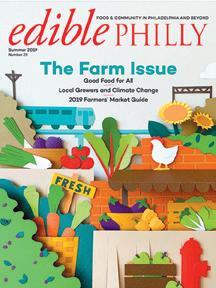









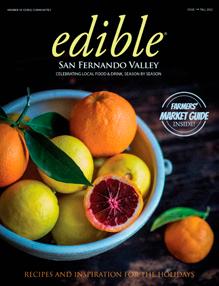



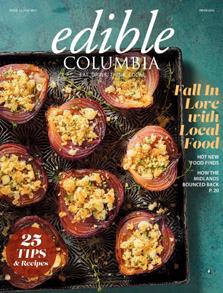











Subscribe to our newsletter! Delivered to your inbox every other Saturday morning and filled with authentic stories and inspired recipes from Edible magazines across the U.S. and Canada. Join us as we celebrate local foods season by season!

































Get Social! Follow us by scanning the QR code above. edible brooklyn ISSUE T H E Drinks edible Cape Cod edible manhattan The future of food MILK & HONEY the land ~ the sea ~ the people ~ the food edible M aritimes
WORDS BY JENNIFER BLAIR
Island symbiosis, sustainably
Three P.E.I. foragers on the bounty of the season
As the days grow longer and the temperatures rise, the world around us comes alive with edible delights. Whether it's the coast spanning ‘tip to tip’, or a babbling brook snaking behind the farm fields, Prince Edward Island’s beaches, salt marshes, streams, and forests make for not only stunning scenery but excellent resources for wild food. In fact, P.E.I. offers a bounty of foodstuffs beyond the farm and fisheries and summer is the perfect time to acquaint ourselves with the edibles all around.
Foraging is the act of searching for and gathering food, but for many local foragers, it’s more than just about the sustenance. “Foraging is meant to be a fun way to connect yourself to the landscape,” says Nick Chindamo, a lifelong forager who lives in Charlottetown. Kate MacQuarrie, a trained botanist with 30 years of foraging experience, concurs: “I like the practicality and the way it links me to those who came before and the traditional ways.” Being outdoors, among local specimens, and the thrill of a find are other draws that appeal to foragers.
Summer brings lots of daylight, adventure, and growth. For foragers like Kate and Nick, summer is an active season as there’s so much to collect: sea vegetables, flowers, and the sheer amount of greens give this season a special place in the hearts of foragers. Jay, a forager from Fortune, and Nick both allude to the special relationship with specimens that develops when you visit them throughout a season. “Summer foraging is a time of early recognition. It’s about learning the weather patterns and spotting what will be ripe later in the year,” explains Jay, Nick furthers this sentiment, suggesting “each interaction with the plant feels new—yet familiar—and gives you a new part of it to harvest for the table. Take common milkweed, for example, Asclepias syriaca Its shoots come up in early May and taste like a delicious cross between broccoli and asparagus. A few weeks later the unopened flower buds emerge and give you another delicious vegetable to harvest. Another week or two later come the opened flowers, which are great for infusions and
pickling. After that, the seed pods, when they’re just an inch or two long and no fluff has developed inside, give you a vegetable not unlike okra in flavour.” From early shoots and buds to seed pods, the same plant can offer a range of edible options throughout the season, if harvested sustainably. Talk about a symbiotic relationship!
P.E.I. may be small in size but the foraging opportunities are many. The Island boasts freshwater streams and saltwater rivers, offering up delightful treats like cattail and clams. Those who head to the coast may be rewarded with PEI’s iconic blue mussels and dulse. If the sun is high and you’re longing for the shade of the forest’s canopy, the forest floor offers up white morrels and ginseng. Foraging finds can be as close as your backyard, where you might find pineapple weed or versatile plantain.
When getting started Nick, who forages year-round, suggests learning one plant at a time and going easy on yourself. Nick, Jay, and Kate all recommend taking to the field (or beach or marsh) with a knowledgeable forager, someone who can identify the specimens that are of interest to you. In-person and online foraging groups are happy to help and answer questions. Don’t rely solely on identification apps. Consult experienced foragers and do your research. Research is your friend. Speaking of friends, you’ll make more if you’re a responsible forager: avoid trespassing by checking an online Public Land Atlas and/or ensure you have permission from the landowner before heading out. To keep the ecosystem happy and healthy, never take more than you need and research how to harvest each plant you collect sustainably.
Lastly, and most importantly, enjoy yourself and the experience. You can enjoy your wild delights in their raw glory or get creative and incorporate them into a recipe. “Foraging is meant to be a fun way to connect yourself to the landscape,” Nick reminds us. “Take it slow, and give it time, respect, and patience—it’s a lifelong journey!”
Jay Foragers' Favourites:

"Flower petals for jellies (rose, apple, fireweed) and fritters (Wild Carrot); Yellow Sorrel; Pineapple Weed. I'm also a big fan of salty saltmarsh species like Seaside Plantain and Glasswort."
Kate MacQuarrie

"Wild Strawberries and Sorrel"

"I head for the coast, where the sea vegetables are thriving: Samphire greens, sea rocket, sea arrowgrass (wild coriander), sea wort, and sea blite - the list goes on!"
Nick Chindamo
Jennifer's Foraging Tips
Looking to deepen your connection to the landscape around you this summer? Why not give foraging a try?
Start in your own yard or nearby (public) areas and get to know what's out there—with no more than a knife, knowledge of what you’re harvesting and a field or foraging guide book, a receptacle to carry your findings—such as a basket or bag.
A hat, sunscreen, insect repellent, and enough water to stay hydrated are important when setting out in the summer. And don’t forget to check for ticks when you come in from the field.
Tread lightly and forage little, leaving more than you take.

Editors' recommendations: Foraging guides we like include Jamie Simpson's Eating Wild in Eastern Canada and Katie Letcher Lyle's Edible Wild Plants, Mushrooms, Fruits, and Nuts
A true Taurus, Jennifer Blair has always appreciated good food and the great outdoors. Jennifer is thrilled to call Prince Edward Island home with her two cats and fiancé.
PHOTO: LABRADOR TEA BY DAVE SNOW
You know the old saying ‘it’s not the destination, it’s the journey’?

Book your Maritime adventure today.

NEW BRUNSWICK - NOVA SCOTIA PRINCE EDWARD ISLAND - NOVA SCOTIA MAINE - NOVA SCOTIA Ferries.ca
MAKE THE FERRY PART OF YOURS.












































 WORDS BY SARA SNOW PHOTOS BY DAVE SNOW
Nigel Eddy and Jolène Thibault put all their eggs in Marché Dumais Market
WORDS BY SARA SNOW PHOTOS BY DAVE SNOW
Nigel Eddy and Jolène Thibault put all their eggs in Marché Dumais Market




























































































































































